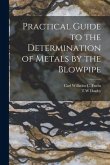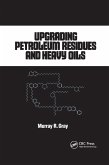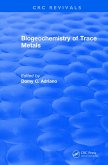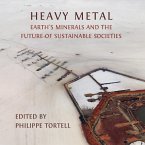Control of Heavy Metals in the Environment (Three-Volume Set)
Herausgeber: Chen, Jiaping Paul; Hung, Yung-Tse; Wang, Mu-Hao Sung; Wang, Lawrence K.
Control of Heavy Metals in the Environment (Three-Volume Set)
Herausgeber: Chen, Jiaping Paul; Hung, Yung-Tse; Wang, Mu-Hao Sung; Wang, Lawrence K.
- Broschiertes Buch
- Merkliste
- Auf die Merkliste
- Bewerten Bewerten
- Teilen
- Produkt teilen
- Produkterinnerung
- Produkterinnerung
Offering broad coverage of both basic and advanced principals and applications, this volume provides chemical and environmental engineers with the most complete resource available on remediation of heavy metal contaminants with an emphasis on innovative and alternative approaches.
Andere Kunden interessierten sich auch für
![Rivers of the Asian Highlands Rivers of the Asian Highlands]() Ruth GambleRivers of the Asian Highlands41,99 €
Ruth GambleRivers of the Asian Highlands41,99 €![The Gold-seeker's Handbook and Practical Assayist [microform]: Intended to Be Used in the Detection of Gold, Silver, Copper, and Other Metals Found in The Gold-seeker's Handbook and Practical Assayist [microform]: Intended to Be Used in the Detection of Gold, Silver, Copper, and Other Metals Found in]() Thomas HughesThe Gold-seeker's Handbook and Practical Assayist [microform]: Intended to Be Used in the Detection of Gold, Silver, Copper, and Other Metals Found in18,99 €
Thomas HughesThe Gold-seeker's Handbook and Practical Assayist [microform]: Intended to Be Used in the Detection of Gold, Silver, Copper, and Other Metals Found in18,99 €![Practical Guide to the Determination of Metals by the Blowpipe Practical Guide to the Determination of Metals by the Blowpipe]() Practical Guide to the Determination of Metals by the Blowpipe20,99 €
Practical Guide to the Determination of Metals by the Blowpipe20,99 €![The Handy Book; Containing Tables, Rules and Other Information Regarding the Working of the Precious Metals The Handy Book; Containing Tables, Rules and Other Information Regarding the Working of the Precious Metals]() The Handy Book; Containing Tables, Rules and Other Information Regarding the Working of the Precious Metals16,99 €
The Handy Book; Containing Tables, Rules and Other Information Regarding the Working of the Precious Metals16,99 €![Upgrading Petroleum Residues and Heavy Oils Upgrading Petroleum Residues and Heavy Oils]() R Murray GrayUpgrading Petroleum Residues and Heavy Oils94,99 €
R Murray GrayUpgrading Petroleum Residues and Heavy Oils94,99 €![Biogeochemistry of Trace Metals Biogeochemistry of Trace Metals]() Biogeochemistry of Trace Metals119,99 €
Biogeochemistry of Trace Metals119,99 €![Heavy Metal Heavy Metal]() Philippe TortellHeavy Metal88,99 €
Philippe TortellHeavy Metal88,99 €-
-
-
Offering broad coverage of both basic and advanced principals and applications, this volume provides chemical and environmental engineers with the most complete resource available on remediation of heavy metal contaminants with an emphasis on innovative and alternative approaches.
Hinweis: Dieser Artikel kann nur an eine deutsche Lieferadresse ausgeliefert werden.
Hinweis: Dieser Artikel kann nur an eine deutsche Lieferadresse ausgeliefert werden.
Produktdetails
- Produktdetails
- Verlag: Taylor & Francis Ltd
- Seitenzahl: 1822
- Erscheinungstermin: 14. März 2025
- Englisch
- Abmessung: 254mm x 178mm
- ISBN-13: 9781032588537
- ISBN-10: 1032588535
- Artikelnr.: 71184769
- Herstellerkennzeichnung
- Libri GmbH
- Europaallee 1
- 36244 Bad Hersfeld
- gpsr@libri.de
- Verlag: Taylor & Francis Ltd
- Seitenzahl: 1822
- Erscheinungstermin: 14. März 2025
- Englisch
- Abmessung: 254mm x 178mm
- ISBN-13: 9781032588537
- ISBN-10: 1032588535
- Artikelnr.: 71184769
- Herstellerkennzeichnung
- Libri GmbH
- Europaallee 1
- 36244 Bad Hersfeld
- gpsr@libri.de
Lawrence K. Wang has served the society as a professor, inventor, chief engineer, chief editor and public servant (UN, USEPA, New York State) for 50+ years, with experience in entire field of environmental science, technology, engineering and mathematics (STEM). He is a licensed NY-MA-NJ-PA-OH Professional Engineer, a certified NY-MA-RI Laboratory Director, a licensed MA-NY Water Operator, and an OSHA Instructor. He has special passion, and expertise in developing various innovative technologies, educational programs, licensing courses, international projects, academic publications, and humanitarian organizations, all for his dream goal of promoting world peace. He is a retired Acting President/Professor of the Lenox Institute of Water Technology, a Senior Advisor of the United Nations Industrial Development Organization (UNIDO), Vienna, Austria, and a former professor/visiting professor at Rensselaer Polytechnic Institute, Stevens Institute of Technology, University of Illinois, National Cheng-Kung University, Zhejiang University, and Tongji University. Dr. Wang is the author of 750+ papers and 50+ books and is credited with 29 invention patents. He holds a BSCE degree from National Cheng-Kung University, Taiwan, ROC, a MSCE degree from the University of Missouri, a MS degree from the University of Rhode Island and a PhD degree from Rutgers University. Dr. Wang has been a Delegate of the People to People International Foundation, a Diplomate of the American Academy of Environmental Engineers, a member of ASCE, AIChE, ASPE, WEF, AWWA, CIE and OCEESA, and a recipient of many US and international engineering and science awards. Mu-Hao Sung Wang has been an engineer of the New York State Department of Environmental Conservation, an editor of CRC Press and Lenox Institute Press, and a university professor at the Stevens Institute of Technology, National Cheng-Kung University, and the Lenox Institute of Water Technology. She has been a government official, and an educator in the US and Taiwan for over 50 years. Dr. Wang is a licensed Professional Engineer, and a Diplomate of the American Academy of Environmental Engineers (AAEE). Her publications have been in the areas of water quality, modeling, environmental sustainability, solid and hazardous waste management, NPDES, flotation technology, industrial waste treatment, and analytical methods. Dr. Wang is the author of over 60 publications and an inventor of 14 US and foreign patents. She holds a BSCE degree from National Cheng-Kung University, Taiwan, ROC, a MS degree from the University of Rhode Island, RI, and a PhD degree from Rutgers University. She is the Coeditor of the Advances in Industrial and Hazardous Wastes Treatment series (Taylor & Francis Group), and the Co-Series Editor of the Environmental Science, Technology, Engineering and Mathematics series (Lenox Institute Press). She is a member of AWWA, NYWWA, NEWWA, WEF, NEWEA, CIE and OCEESA.
1.
Innovative Process Systems Including Dissolved Air Flotation, Protein
Separation, Flue Gas Reuse, Sulfide Precipitation, And Chromium Removal for
Tannery Waste Treatment. Titanium Dioxide Recovery, Filter Retention and
White Water Treatment Using Flotation And Membrane Filtration. Adsorptive
Amputation of Heavy Metals from Aqueous Solution and Textile Wastewater by
Heinsia Crinita Seed Coat Biomass. Protection of Biosystem Organisms in
Heavy Metals-Contaminated Environment by Using Molecular Hydrogen.
Application of Ion Exchange Resin in the Removal of Pollutants from
Wastewater. Metal-Organic Framework 5 (Mof-5) Composites: From Synthesis
Optimization to Its Application in Textile Industry Wastewater Treatment.
Heavy Metal Pollution Resulting from Industrial Wastes Used for Soil
Stabilization in Groundwater. Treatment Of Coal Coking Wastewater.
Treatment of Metalworking Fluids and Wastewaters. Hazardous Wastewater
Treatment in Petroleum Refining Industry Using Best Available Flotation and
Filtration Technologies.
2.
Urban Area Sludge Treatment Using Pressurized Oxygenation-Ozonation,
Dissolved Gas Flotation and Dewatering. Strategies for Bioremediation of
Heavy Metals Contaminated Industrial Effluents. Surface Engineering of
Colloidal Quaternary Chalcogenide Cu2znsns4 Nanocrystals Via Ligand
Exchange for Photo-Induced Charge Separation Applications for Water
Remediation. Mining And Industrial Iron-Based Wastes: Environmental
Impacts, Treatment, and Recycling. Utilization of Fungal Bioprocess in
Heavy Metal Contaminated Water Treatment Technologies. Depletion of
Hexavalent Chromium to Trivalent Chromium from Tannery Industry Effluent
Using Natural Bacterial Biomass. Reductions of Color, Turbidity, Humic
Acid, Metals, Edb, and Tthm by Adsorption, Flotation and Filtration.
Removal of Iron, Copper, Coliform Bacteria and Hardness from Cooling Tower
Water Dissolved Air-Ozone Flotation. Ecologically Sustainable Industrial
Development, Solid and Hazardous Wastes Management, and Daf Landfill
Leachate Pretreatment: Unido Efforts. Innovative Process System Consisting
of Dissolved Air Flotation, Recarbonation and Filtration, Using Lime and
Sodium Aluminate for Removal of Hardness, Iron and Manganese from
Groundwater. Removal of Arsenic by Dissolved Air Flotation, Filtration and
Granular Activated Carbon. Removal of Arsenic by Dissolved Flotation,
Filtration and Ion Exchange.
3.
Metal Research Trends in the Environmental Field. Toxicity and Sources of
Pb, Cd, Hg, Cr, As, and Radionuclides in the Environment. Environmental
Behavior and Effects of Engineered Metal and Metal Oxide Nanoparticles.
Heavy Metal Removal with Exopolysaccharide-Producing Cyanobacteria.
Environmental Geochemistry of High-Arsenic Aquifer Systems. Nanotechnology
Application in Metal Ion Adsorption. Biosorption of Metals onto Granular
Sludge. Arsenic Pollution: Occurrence, Distribution, and Technologies.
Treatment of Metal-Bearing Effluents: Removal and Recovery. Management and
Treatment of Acid Pickling Wastes Containing Heavy Metals. Treatment and
Management of Metal Finishing Industry Wastes. Recycling and Disposal of
Hazardous Solid Wastes Containing Heavy Metals and Other Toxic Substances.
Management and Removal of Heavy Metals from Contaminated Soil. Remediation
of Metal Finishing Brownfi eld Sites. Control, Management, and Treatment of
Metal Emissons from Motor Vehicles.
Innovative Process Systems Including Dissolved Air Flotation, Protein
Separation, Flue Gas Reuse, Sulfide Precipitation, And Chromium Removal for
Tannery Waste Treatment. Titanium Dioxide Recovery, Filter Retention and
White Water Treatment Using Flotation And Membrane Filtration. Adsorptive
Amputation of Heavy Metals from Aqueous Solution and Textile Wastewater by
Heinsia Crinita Seed Coat Biomass. Protection of Biosystem Organisms in
Heavy Metals-Contaminated Environment by Using Molecular Hydrogen.
Application of Ion Exchange Resin in the Removal of Pollutants from
Wastewater. Metal-Organic Framework 5 (Mof-5) Composites: From Synthesis
Optimization to Its Application in Textile Industry Wastewater Treatment.
Heavy Metal Pollution Resulting from Industrial Wastes Used for Soil
Stabilization in Groundwater. Treatment Of Coal Coking Wastewater.
Treatment of Metalworking Fluids and Wastewaters. Hazardous Wastewater
Treatment in Petroleum Refining Industry Using Best Available Flotation and
Filtration Technologies.
2.
Urban Area Sludge Treatment Using Pressurized Oxygenation-Ozonation,
Dissolved Gas Flotation and Dewatering. Strategies for Bioremediation of
Heavy Metals Contaminated Industrial Effluents. Surface Engineering of
Colloidal Quaternary Chalcogenide Cu2znsns4 Nanocrystals Via Ligand
Exchange for Photo-Induced Charge Separation Applications for Water
Remediation. Mining And Industrial Iron-Based Wastes: Environmental
Impacts, Treatment, and Recycling. Utilization of Fungal Bioprocess in
Heavy Metal Contaminated Water Treatment Technologies. Depletion of
Hexavalent Chromium to Trivalent Chromium from Tannery Industry Effluent
Using Natural Bacterial Biomass. Reductions of Color, Turbidity, Humic
Acid, Metals, Edb, and Tthm by Adsorption, Flotation and Filtration.
Removal of Iron, Copper, Coliform Bacteria and Hardness from Cooling Tower
Water Dissolved Air-Ozone Flotation. Ecologically Sustainable Industrial
Development, Solid and Hazardous Wastes Management, and Daf Landfill
Leachate Pretreatment: Unido Efforts. Innovative Process System Consisting
of Dissolved Air Flotation, Recarbonation and Filtration, Using Lime and
Sodium Aluminate for Removal of Hardness, Iron and Manganese from
Groundwater. Removal of Arsenic by Dissolved Air Flotation, Filtration and
Granular Activated Carbon. Removal of Arsenic by Dissolved Flotation,
Filtration and Ion Exchange.
3.
Metal Research Trends in the Environmental Field. Toxicity and Sources of
Pb, Cd, Hg, Cr, As, and Radionuclides in the Environment. Environmental
Behavior and Effects of Engineered Metal and Metal Oxide Nanoparticles.
Heavy Metal Removal with Exopolysaccharide-Producing Cyanobacteria.
Environmental Geochemistry of High-Arsenic Aquifer Systems. Nanotechnology
Application in Metal Ion Adsorption. Biosorption of Metals onto Granular
Sludge. Arsenic Pollution: Occurrence, Distribution, and Technologies.
Treatment of Metal-Bearing Effluents: Removal and Recovery. Management and
Treatment of Acid Pickling Wastes Containing Heavy Metals. Treatment and
Management of Metal Finishing Industry Wastes. Recycling and Disposal of
Hazardous Solid Wastes Containing Heavy Metals and Other Toxic Substances.
Management and Removal of Heavy Metals from Contaminated Soil. Remediation
of Metal Finishing Brownfi eld Sites. Control, Management, and Treatment of
Metal Emissons from Motor Vehicles.
1.
Innovative Process Systems Including Dissolved Air Flotation, Protein
Separation, Flue Gas Reuse, Sulfide Precipitation, And Chromium Removal for
Tannery Waste Treatment. Titanium Dioxide Recovery, Filter Retention and
White Water Treatment Using Flotation And Membrane Filtration. Adsorptive
Amputation of Heavy Metals from Aqueous Solution and Textile Wastewater by
Heinsia Crinita Seed Coat Biomass. Protection of Biosystem Organisms in
Heavy Metals-Contaminated Environment by Using Molecular Hydrogen.
Application of Ion Exchange Resin in the Removal of Pollutants from
Wastewater. Metal-Organic Framework 5 (Mof-5) Composites: From Synthesis
Optimization to Its Application in Textile Industry Wastewater Treatment.
Heavy Metal Pollution Resulting from Industrial Wastes Used for Soil
Stabilization in Groundwater. Treatment Of Coal Coking Wastewater.
Treatment of Metalworking Fluids and Wastewaters. Hazardous Wastewater
Treatment in Petroleum Refining Industry Using Best Available Flotation and
Filtration Technologies.
2.
Urban Area Sludge Treatment Using Pressurized Oxygenation-Ozonation,
Dissolved Gas Flotation and Dewatering. Strategies for Bioremediation of
Heavy Metals Contaminated Industrial Effluents. Surface Engineering of
Colloidal Quaternary Chalcogenide Cu2znsns4 Nanocrystals Via Ligand
Exchange for Photo-Induced Charge Separation Applications for Water
Remediation. Mining And Industrial Iron-Based Wastes: Environmental
Impacts, Treatment, and Recycling. Utilization of Fungal Bioprocess in
Heavy Metal Contaminated Water Treatment Technologies. Depletion of
Hexavalent Chromium to Trivalent Chromium from Tannery Industry Effluent
Using Natural Bacterial Biomass. Reductions of Color, Turbidity, Humic
Acid, Metals, Edb, and Tthm by Adsorption, Flotation and Filtration.
Removal of Iron, Copper, Coliform Bacteria and Hardness from Cooling Tower
Water Dissolved Air-Ozone Flotation. Ecologically Sustainable Industrial
Development, Solid and Hazardous Wastes Management, and Daf Landfill
Leachate Pretreatment: Unido Efforts. Innovative Process System Consisting
of Dissolved Air Flotation, Recarbonation and Filtration, Using Lime and
Sodium Aluminate for Removal of Hardness, Iron and Manganese from
Groundwater. Removal of Arsenic by Dissolved Air Flotation, Filtration and
Granular Activated Carbon. Removal of Arsenic by Dissolved Flotation,
Filtration and Ion Exchange.
3.
Metal Research Trends in the Environmental Field. Toxicity and Sources of
Pb, Cd, Hg, Cr, As, and Radionuclides in the Environment. Environmental
Behavior and Effects of Engineered Metal and Metal Oxide Nanoparticles.
Heavy Metal Removal with Exopolysaccharide-Producing Cyanobacteria.
Environmental Geochemistry of High-Arsenic Aquifer Systems. Nanotechnology
Application in Metal Ion Adsorption. Biosorption of Metals onto Granular
Sludge. Arsenic Pollution: Occurrence, Distribution, and Technologies.
Treatment of Metal-Bearing Effluents: Removal and Recovery. Management and
Treatment of Acid Pickling Wastes Containing Heavy Metals. Treatment and
Management of Metal Finishing Industry Wastes. Recycling and Disposal of
Hazardous Solid Wastes Containing Heavy Metals and Other Toxic Substances.
Management and Removal of Heavy Metals from Contaminated Soil. Remediation
of Metal Finishing Brownfi eld Sites. Control, Management, and Treatment of
Metal Emissons from Motor Vehicles.
Innovative Process Systems Including Dissolved Air Flotation, Protein
Separation, Flue Gas Reuse, Sulfide Precipitation, And Chromium Removal for
Tannery Waste Treatment. Titanium Dioxide Recovery, Filter Retention and
White Water Treatment Using Flotation And Membrane Filtration. Adsorptive
Amputation of Heavy Metals from Aqueous Solution and Textile Wastewater by
Heinsia Crinita Seed Coat Biomass. Protection of Biosystem Organisms in
Heavy Metals-Contaminated Environment by Using Molecular Hydrogen.
Application of Ion Exchange Resin in the Removal of Pollutants from
Wastewater. Metal-Organic Framework 5 (Mof-5) Composites: From Synthesis
Optimization to Its Application in Textile Industry Wastewater Treatment.
Heavy Metal Pollution Resulting from Industrial Wastes Used for Soil
Stabilization in Groundwater. Treatment Of Coal Coking Wastewater.
Treatment of Metalworking Fluids and Wastewaters. Hazardous Wastewater
Treatment in Petroleum Refining Industry Using Best Available Flotation and
Filtration Technologies.
2.
Urban Area Sludge Treatment Using Pressurized Oxygenation-Ozonation,
Dissolved Gas Flotation and Dewatering. Strategies for Bioremediation of
Heavy Metals Contaminated Industrial Effluents. Surface Engineering of
Colloidal Quaternary Chalcogenide Cu2znsns4 Nanocrystals Via Ligand
Exchange for Photo-Induced Charge Separation Applications for Water
Remediation. Mining And Industrial Iron-Based Wastes: Environmental
Impacts, Treatment, and Recycling. Utilization of Fungal Bioprocess in
Heavy Metal Contaminated Water Treatment Technologies. Depletion of
Hexavalent Chromium to Trivalent Chromium from Tannery Industry Effluent
Using Natural Bacterial Biomass. Reductions of Color, Turbidity, Humic
Acid, Metals, Edb, and Tthm by Adsorption, Flotation and Filtration.
Removal of Iron, Copper, Coliform Bacteria and Hardness from Cooling Tower
Water Dissolved Air-Ozone Flotation. Ecologically Sustainable Industrial
Development, Solid and Hazardous Wastes Management, and Daf Landfill
Leachate Pretreatment: Unido Efforts. Innovative Process System Consisting
of Dissolved Air Flotation, Recarbonation and Filtration, Using Lime and
Sodium Aluminate for Removal of Hardness, Iron and Manganese from
Groundwater. Removal of Arsenic by Dissolved Air Flotation, Filtration and
Granular Activated Carbon. Removal of Arsenic by Dissolved Flotation,
Filtration and Ion Exchange.
3.
Metal Research Trends in the Environmental Field. Toxicity and Sources of
Pb, Cd, Hg, Cr, As, and Radionuclides in the Environment. Environmental
Behavior and Effects of Engineered Metal and Metal Oxide Nanoparticles.
Heavy Metal Removal with Exopolysaccharide-Producing Cyanobacteria.
Environmental Geochemistry of High-Arsenic Aquifer Systems. Nanotechnology
Application in Metal Ion Adsorption. Biosorption of Metals onto Granular
Sludge. Arsenic Pollution: Occurrence, Distribution, and Technologies.
Treatment of Metal-Bearing Effluents: Removal and Recovery. Management and
Treatment of Acid Pickling Wastes Containing Heavy Metals. Treatment and
Management of Metal Finishing Industry Wastes. Recycling and Disposal of
Hazardous Solid Wastes Containing Heavy Metals and Other Toxic Substances.
Management and Removal of Heavy Metals from Contaminated Soil. Remediation
of Metal Finishing Brownfi eld Sites. Control, Management, and Treatment of
Metal Emissons from Motor Vehicles.


![The Gold-seeker's Handbook and Practical Assayist [microform]: Intended to Be Used in the Detection of Gold, Silver, Copper, and Other Metals Found in The Gold-seeker's Handbook and Practical Assayist [microform]: Intended to Be Used in the Detection of Gold, Silver, Copper, and Other Metals Found in](https://bilder.buecher.de/produkte/66/66115/66115442m.jpg)
